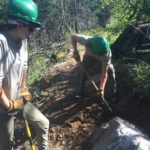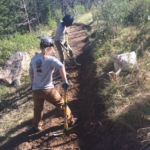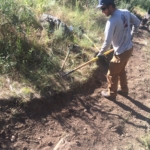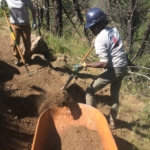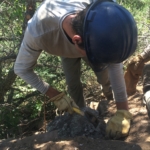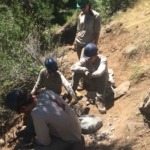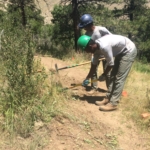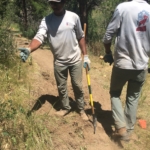After a week spent on the east side of Rocky Mountain National Park for RMC-CC’s educational mid-week, the Kawuneeche Crew returned to the beautiful Kawuneeche Valley. On Monday, we arrived at our comfort station and were pleased to see that in our absence our NPS supervisors replaced nearly all of the windows. After admiring the glimmering glass, we jumped right back into work. In the morning, the crew prepped an area outside the comfort station for a concrete (or as we’ve learned is often called “mud” in the business) sidewalk to be poured later in the week. Prepping the area for concrete included digging out the area four inches deep, and creating a border using wooden boards and stakes. Once this was completed, the rest of our day was spent framing the new windows (to ensure that they stay in place), using wooden boards, a nail gun, and a lot of precise measuring. While half of the crew spent the afternoon doing this, the other half worked on removing grout from the comfort station’s tile floors, via a rotary tool equipped with a specialized and extremely sharp blade.
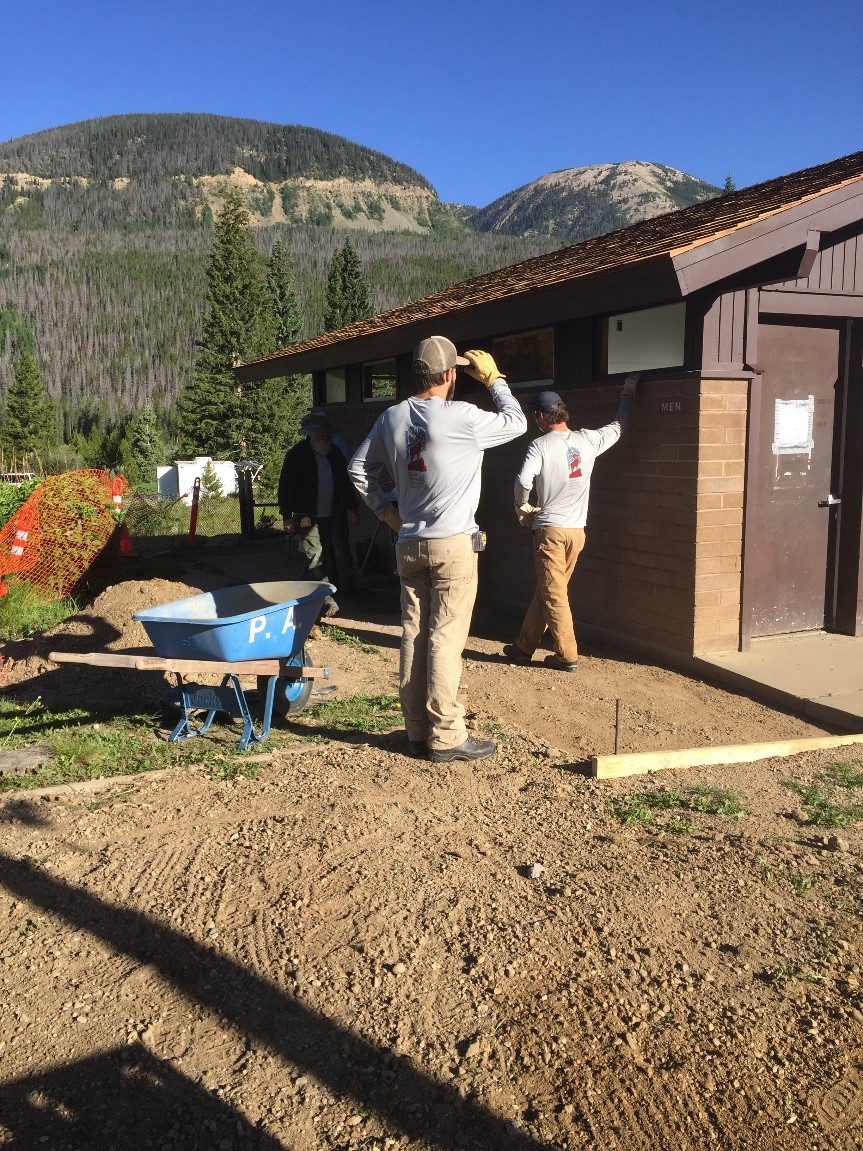
Crew leader Dom and crew member Dax examining and working on the area outside the comfort station to be filled with concrete.
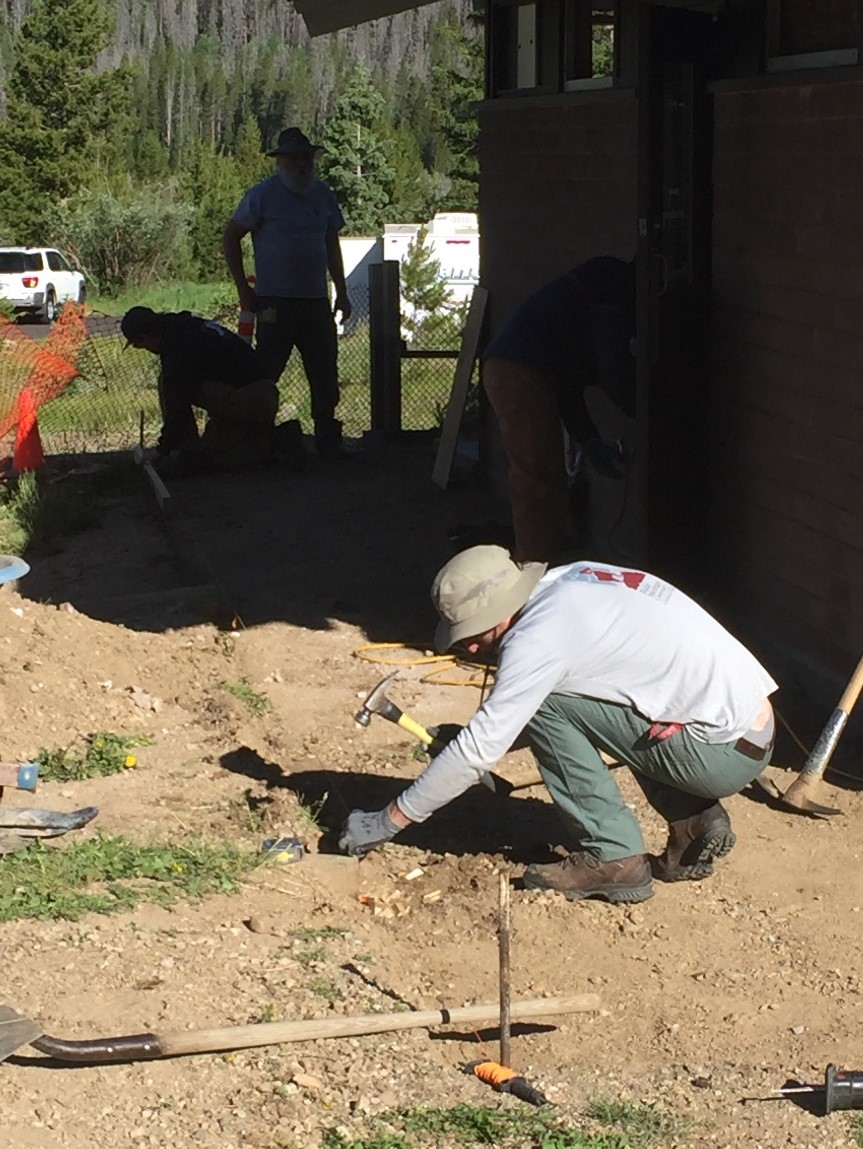

Crew member, Will, working on placing a border around the area outside the comfort station for the concrete sidewalk.
Tuesday brought more window work. In addition to continuing to frame the windows, the crew also replaced the remaining few windows, which are the windows that can be opened and closed to the outside world. (It is also worth noting that we now no longer have to board up the windows before leaving for the day…which is very exciting for us!) In the afternoon, we framed these windows and also worked on removing more grout from the tile floors. Tuesday further consisted of chinking at the Mess Hall up at Lake Irene. And after work on Tuesday afternoon, I, as the assistant crew leader of the week, taught the crew a lesson on making art from nature. After I spoke about some of the history and theory behind nature art, the crew created their own pieces of art from the nature found in our backyard, and explained their pieces to the rest of the crew.
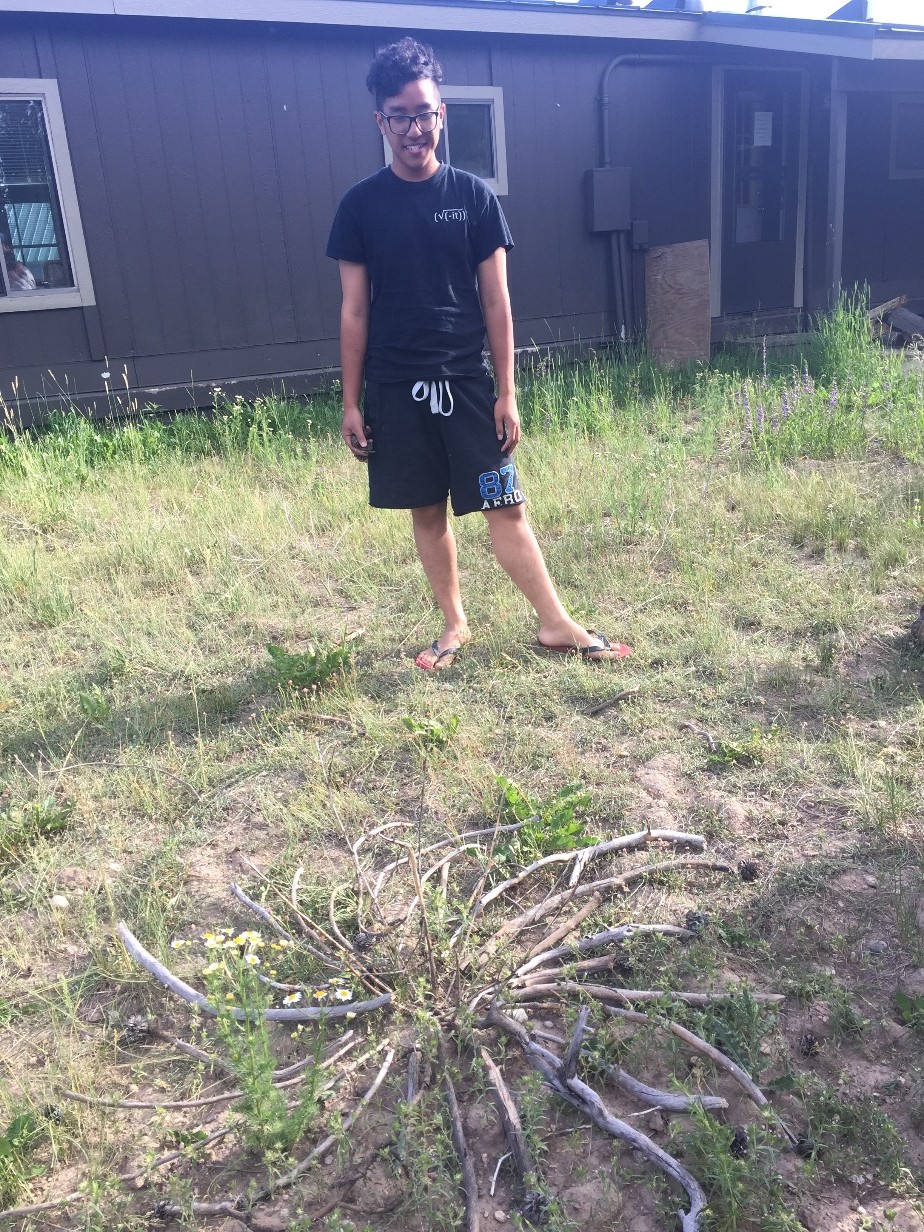

Crew member, Adam, displaying his nature art, in the form of a mandala, to the rest of the crew.
On Wednesday, the crew completed even more grout work. Not only did the crew finish removing the grout (a much more difficult and time consuming task than you might otherwise think, and hence why it took nearly three days to complete) from the women’s side of the comfort station, but crew member Dax and crew leader Dom also grouted the women’s side. This, too, was another time consuming task, as it involved a great deal of waiting for various steps to be completed, namely the washing and drying of the tiles before and after the grout had been placed. Lastly, the other half of the crew spent the day chinking at Lake Irene, working primarily on the corners of the building; and we came incredibly close to completing the project.
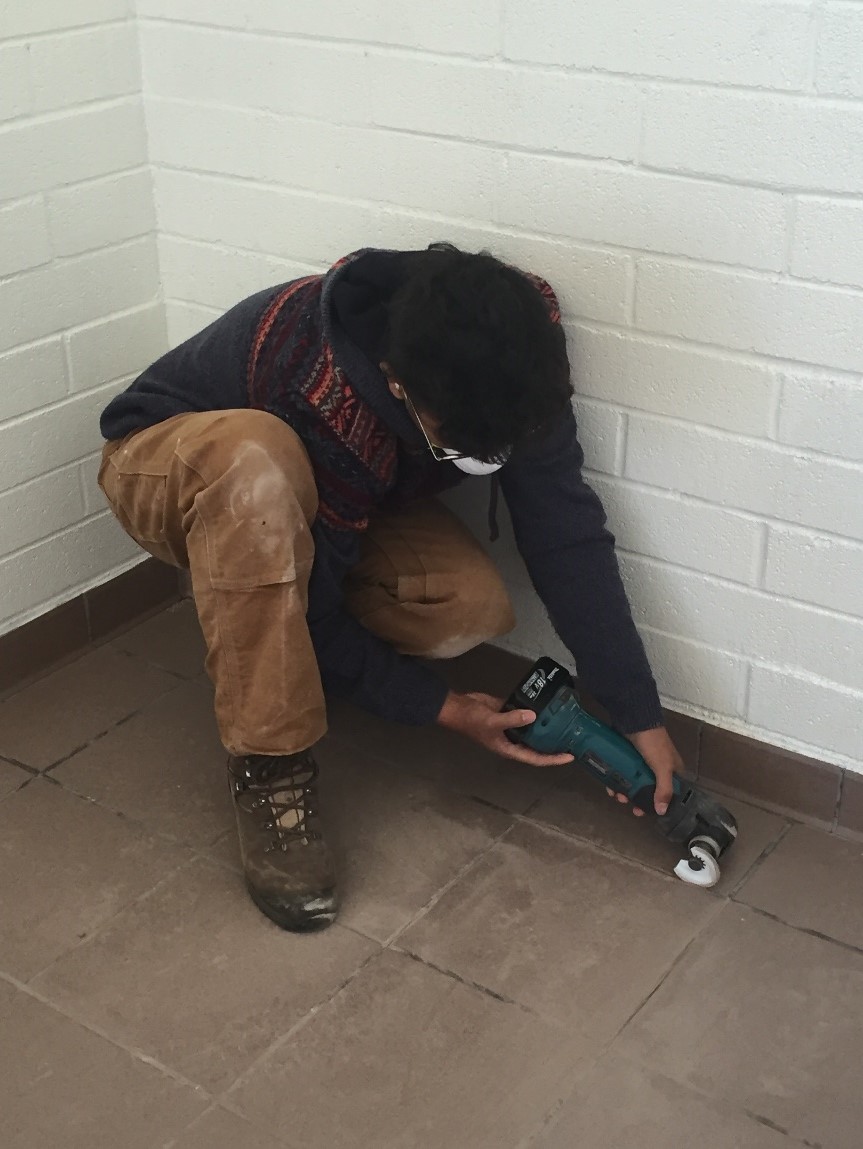

Crew Member, Adam, using the rotary tool to remove grout from the comfort station’s tiles.
Our last work day of the week, Thursday, was an exciting and busy day for the Kawuneeche Crew! While half of the crew spent the day at the comfort station, the other half headed over to the east side of the park to help transport materials for a project next week. At the comfort station, Dom and Dax spent the morning hauling and dumping wheel barrels of concrete from a truck to the area for the sidewalk. Once the concrete was dumped, our NPS supervisors Bob, Chuck, and John spread and evened the concrete into the area. The exterior of the bathroom continues to progress, and now that it has a brand new sidewalk, it looks wonderful! Once the sidewalk was completed, Dom and Dax spent the rest of the day doing (you guessed it!) more grout work. In the meantime, the rest of the crew, including myself, Adam, and Will loaded our work truck with all of the shingles remaining from the re-shingling of the comfort station’s roof a few weeks back. After loading the shingles, we headed up to Lake Irene to finish up chinking the last corner of the Mess Hall. An hour of work later and we were proud to have finished this project for the summer, and it looks fantastic! We then headed over Trail Ridge Road with the shingles (just imagine driving over a curvy, mountain road with a huge, weighted down truck) and unloaded them near the park headquarters. Next, we loaded James’, one of our NPS supervisors, truck with logs and drove to a picnic area near the Wild Basin area to drop them off. Because we needed to take forty logs to this area, we ended up taking two trips. And while we spent a good deal of our day driving, the scenery was beautiful and was a great way to end the start to the second half of the season!
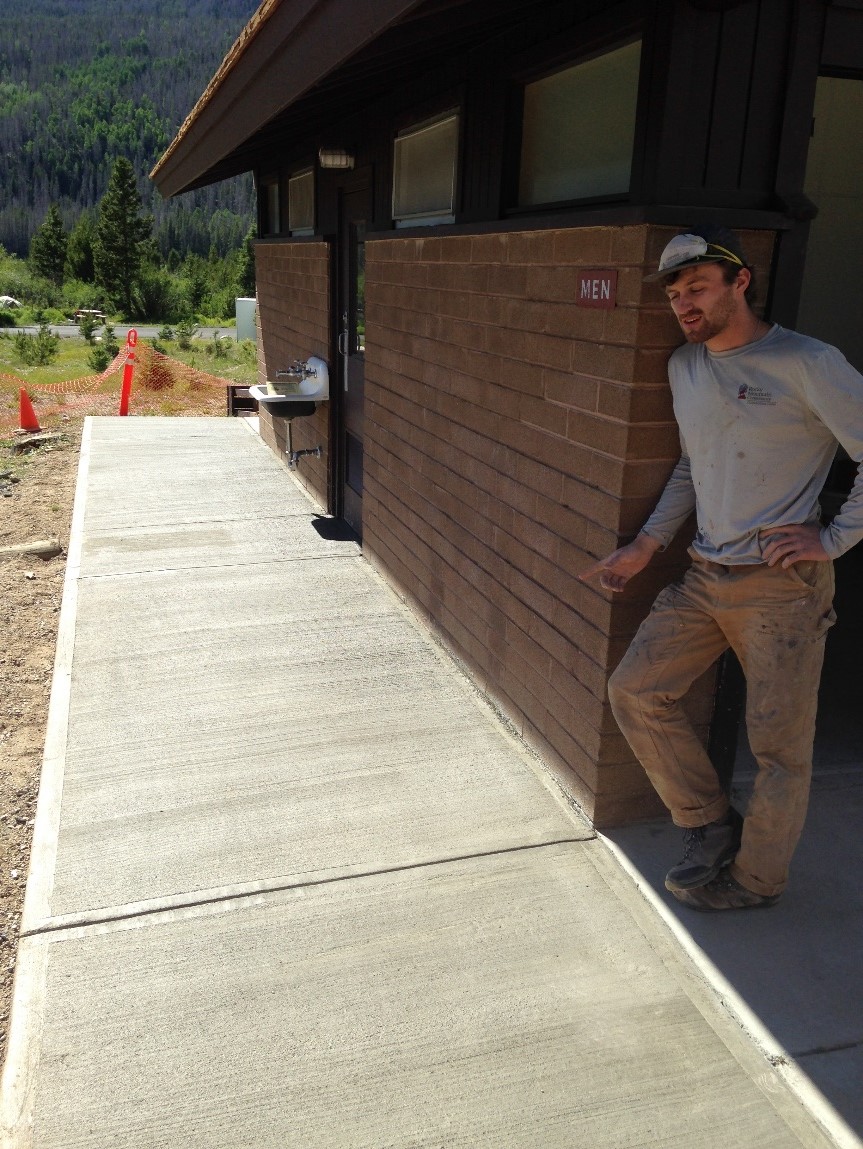

Crew Leader, Dom, admiring the newly poured concrete sidewalk.
Next week, we are looking forward to making more progress on the comfort station and to some new projects on the east side of the park!
-Rachel Eckert, Kawuneeche Crew Leader of the Week
One of my favorite things about the Estes Crew is that we are given opportunities to work in other areas of the park outside of trails. Don’t get me wrong- I absolutely love trail work. However, trail work is not something that everyone is interested in turning into a life-long career. So this week, the members of Estes Crew got to work with the Resource Stewardship division of Rocky and explore more options for future jobs or careers. This week, we worked with a crew that manages the flora of the park by removing invasive plants.
Today, invasive species are one of the largest threats to native plants and wildlife all across the globe, and the culprit is often humans. Rocky Mountain National Park has a huge diversity of plants from the montane life zone all the way to the tundra. This diversity even earned them recognition as a UNESCO Biosphere Reserve. However, it is the beautiful landscape that affords the park recognition and attracts the people that bring with them invasive weeds such as Musk Thistle and Cheatgrass. This is where crews like the one we worked with this week step in.
The main methods for removing invasive weeds are manually removing them and using herbicides applied with a backpack sprayer. Herbicides can sound like a scary thing, right? With some of the invasive species in the park, using herbicides is the best viable option for their removal. For example, simply pulling Canada Thistle does not work, because the roots will then sprout several more plants in the same spot. I can assure you that the NPS employees who manage the plans for invasive weeds rely heavily on the best science available, only use them if they are the best option, and hold their crews to the highest safety standards. The chemicals used in the park are specific to certain plant families, and don’t stay in the environment long. The use of backpack sprayers allows only certain plants to be targeted and there are strict guidelines on where the use of herbicides is allowed. If you would like more information on the use of herbicides in parks, I have provided links at the end of this post.
Thanks for checking back in with our RMC crews! It’s now the weekend and we’re all off to hike, climb, and float the beautiful land that we’re living in.
Rocky Mountain NP Environmental Assessment- Exotic Plant Removal
Yosemite NP Treatment of Invasive Plants
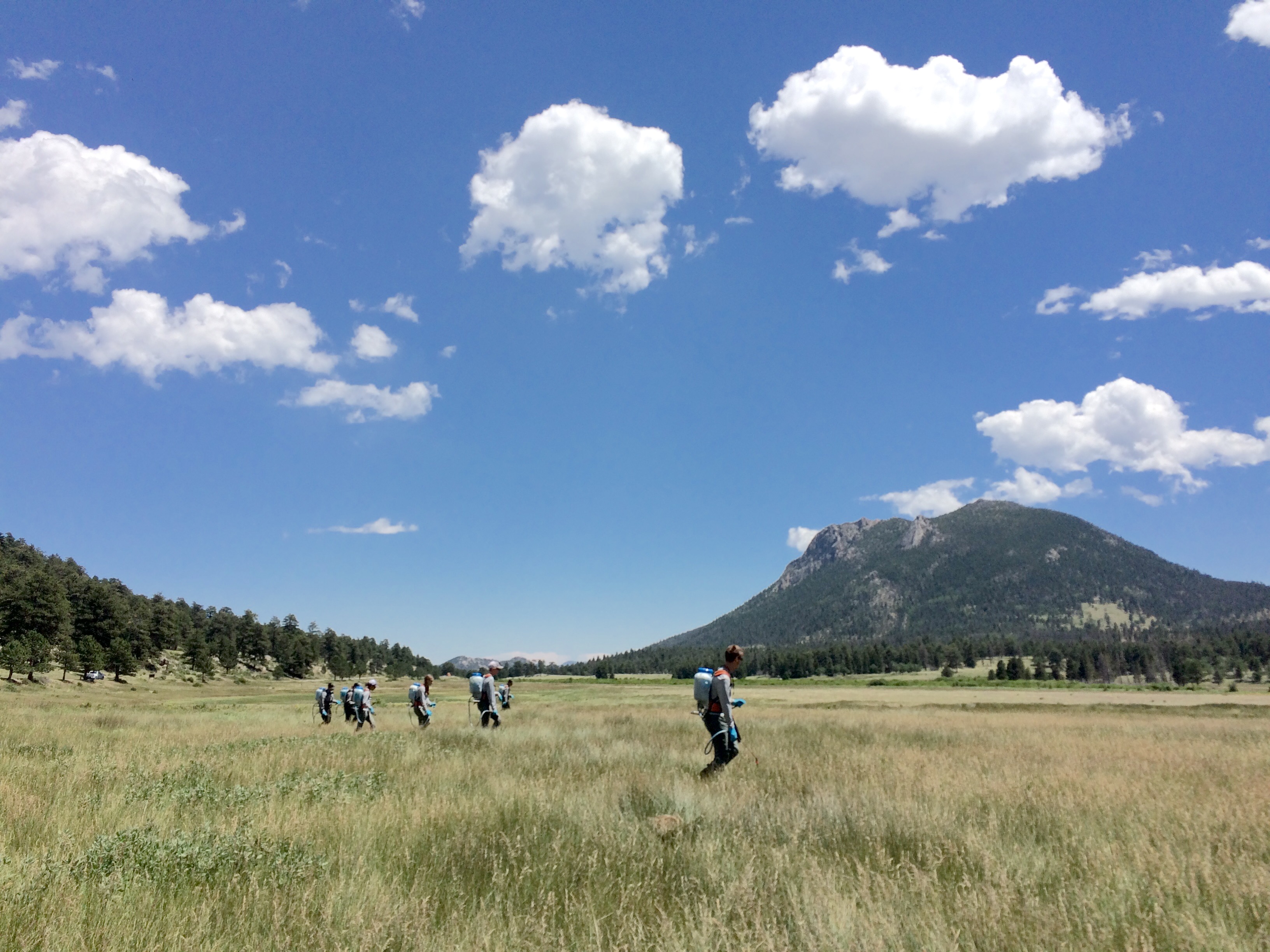

The Estes Crew, along with the Park Service employees, work through a field looking for Musk and Canada Thistle.
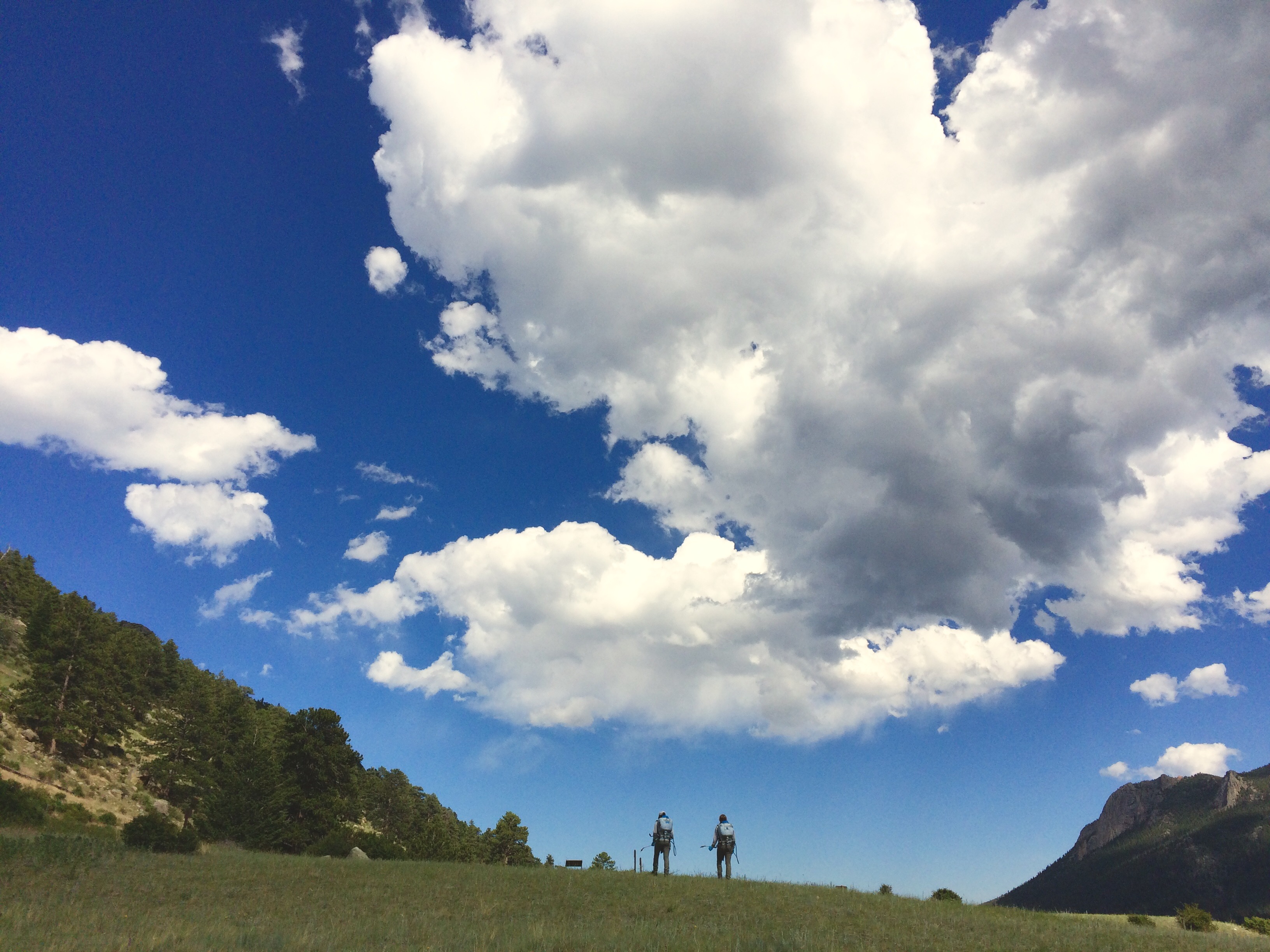

Estes Crew members Jessa and Yuritzi head back to the car at the end of our workday.
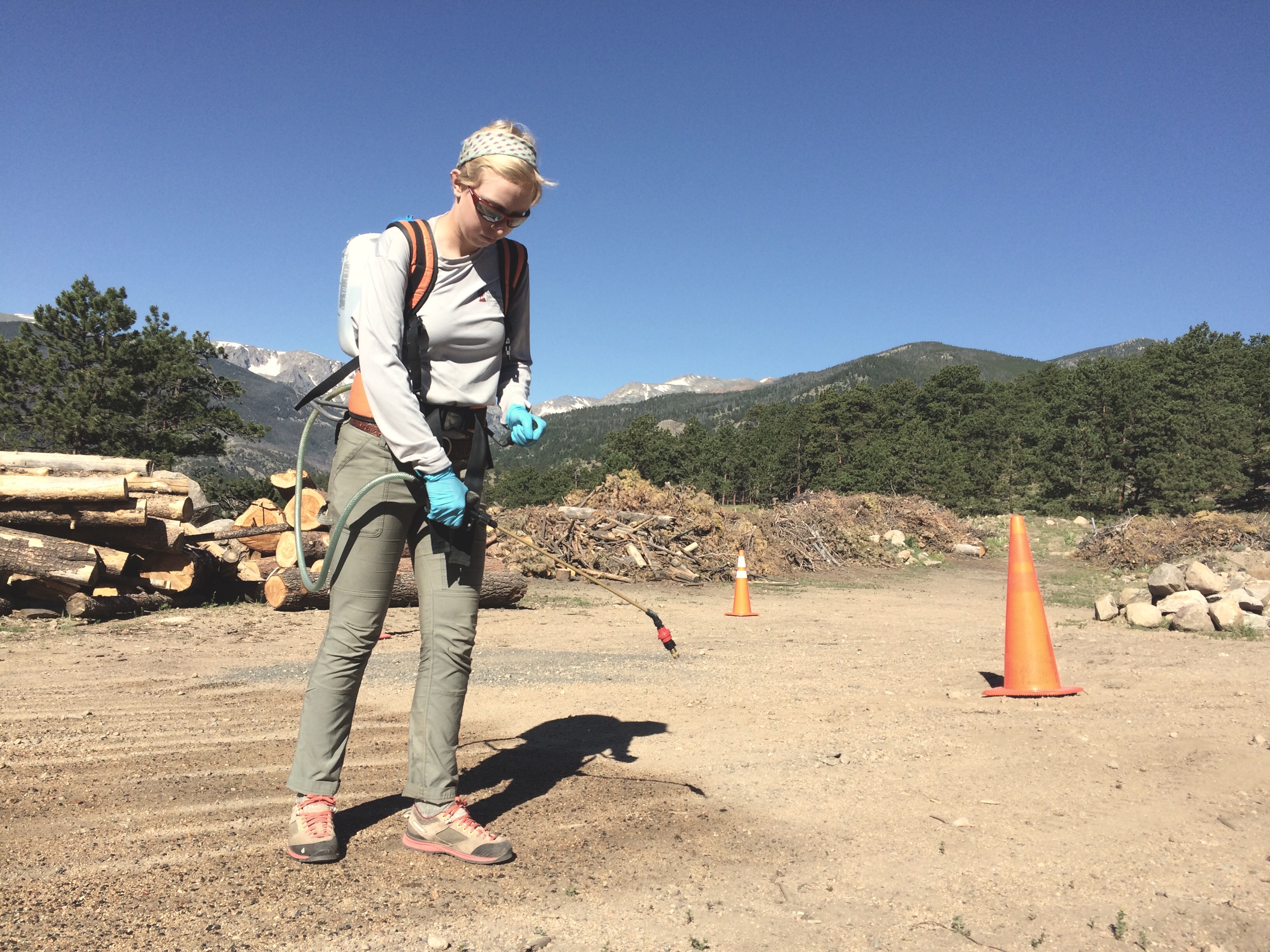

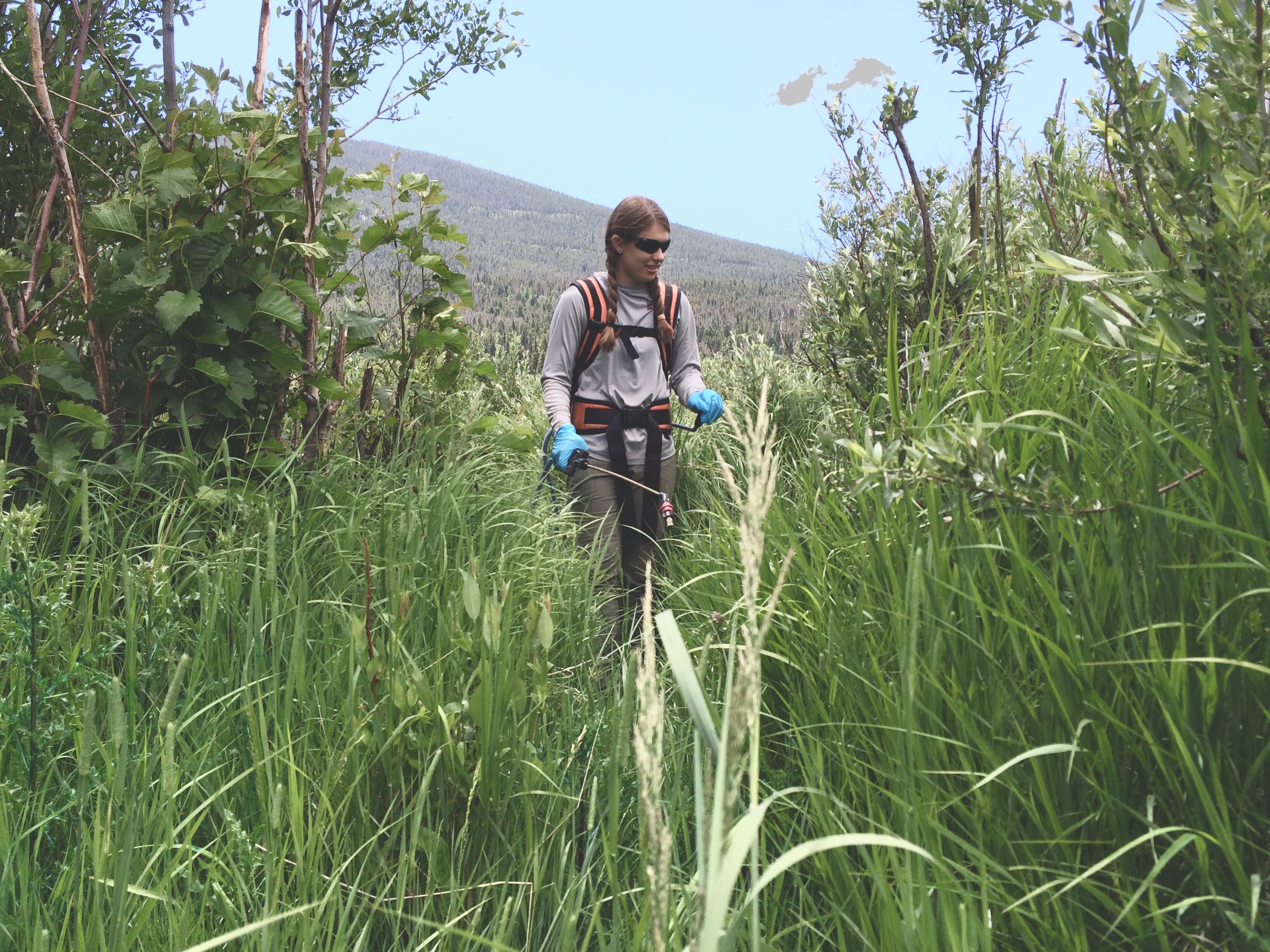

Crewmember Jessa sprays Canada Thistle in the thickets of the Sheep Lakes area of Rocky.
-Miranda Thompson, Estes Crew Leader
Over the course of the last week, the Boulder Crew worked on three main projects. The first of these involved constructing a turnpike within James Peak Wilderness, just south of Nederland. On the first day, we were joined by Geoff Elliot who aided us in the construction of the turnpike. For construction, we spent a great deal of time collecting rocks of all shapes and sizes. The perimeter of the turnpike consisted of very large rocks that required two or more people to carry with the help of a rock austin. Once the outside perimeter of the turnpike was complete, the crew had to line the inside of the turnpike with large rocks followed by smaller rocks, a layer of dirt, more small rocks, and then a final layer of dirt. Having good clean dirt was essential in construction. Crew Leader, Tom Enright, proved to have a true natural ability in selecting the site to borrow dirt from. Tom spent the better part of two days sifting through dirt, removal large impurities, to ensure that we have a pure final product. Way to go Tom! One of the more interesting things we saw while working in James Peak Wilderness was a man walking his three goats on the trail. The most exciting thing we usually see, as far as domesticated wildlife goes, is an abnormally large dog, so it was pretty special to see a small herd of goats.
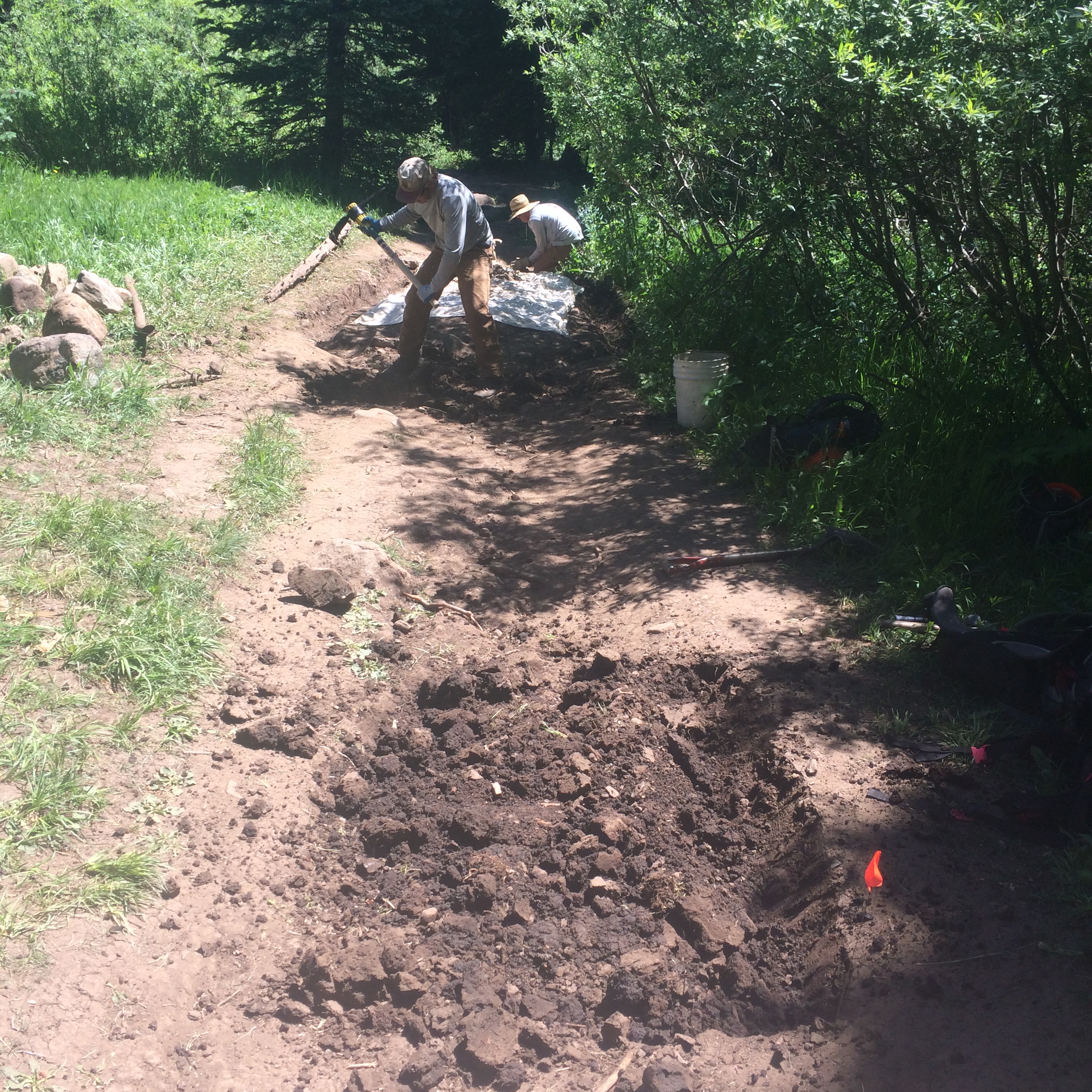

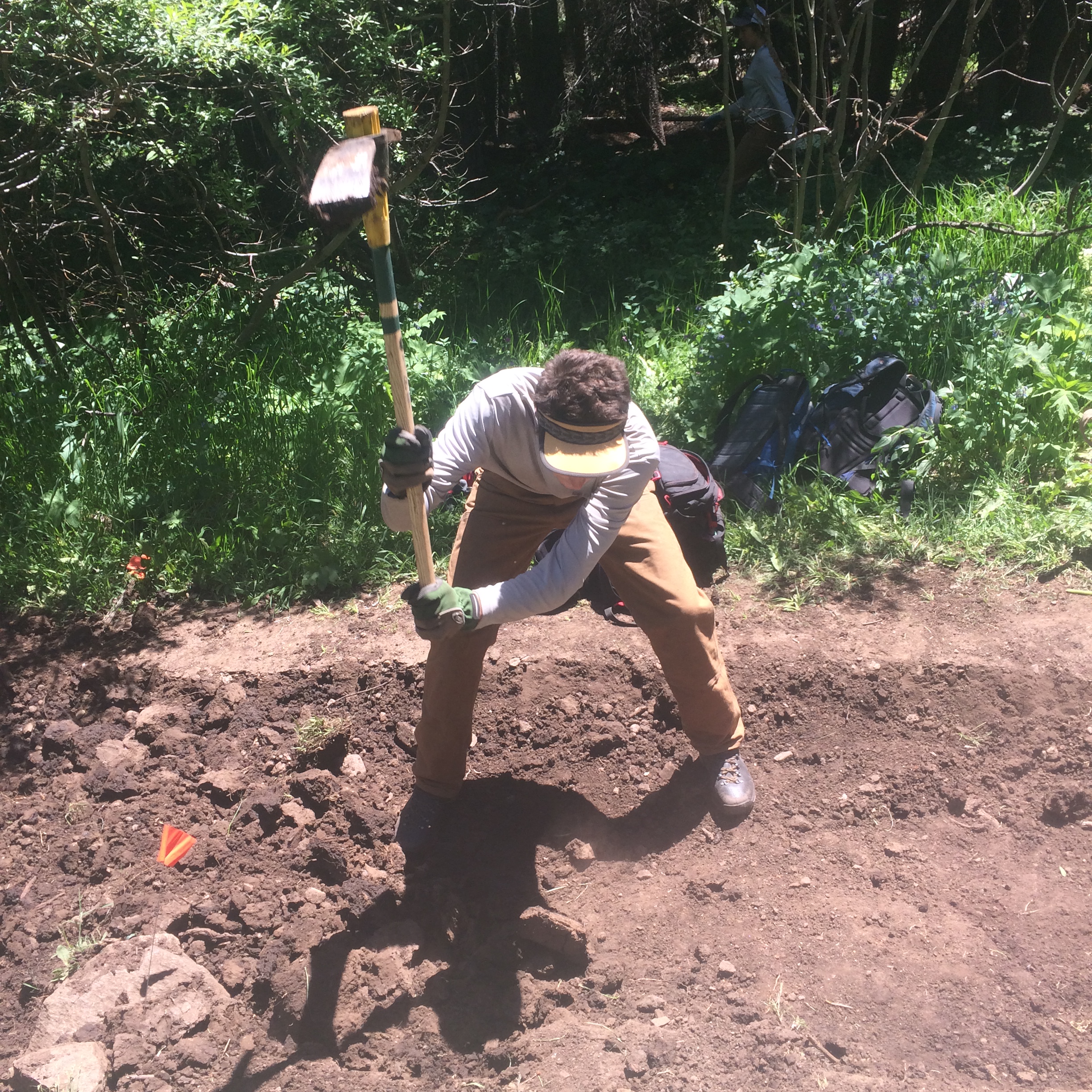

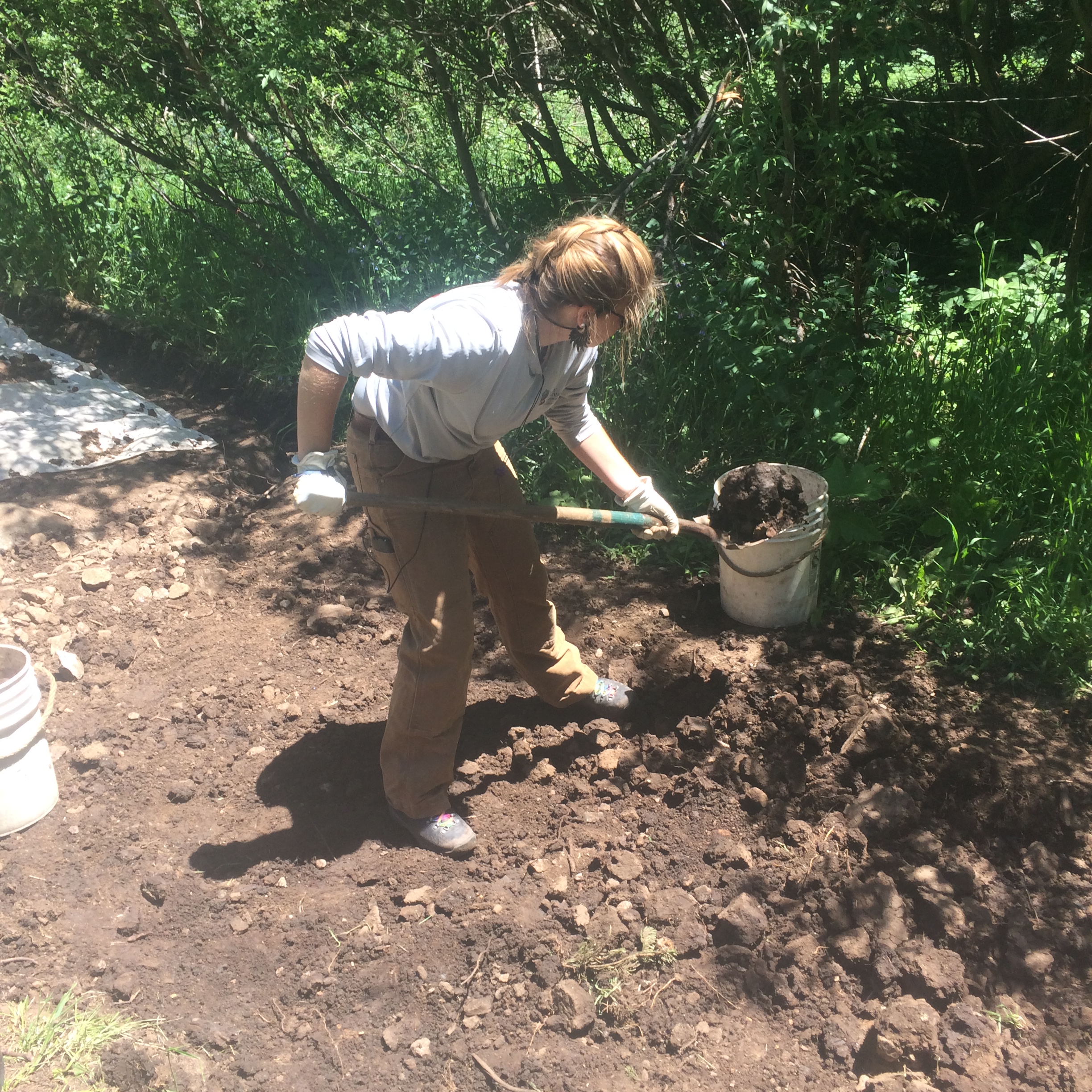

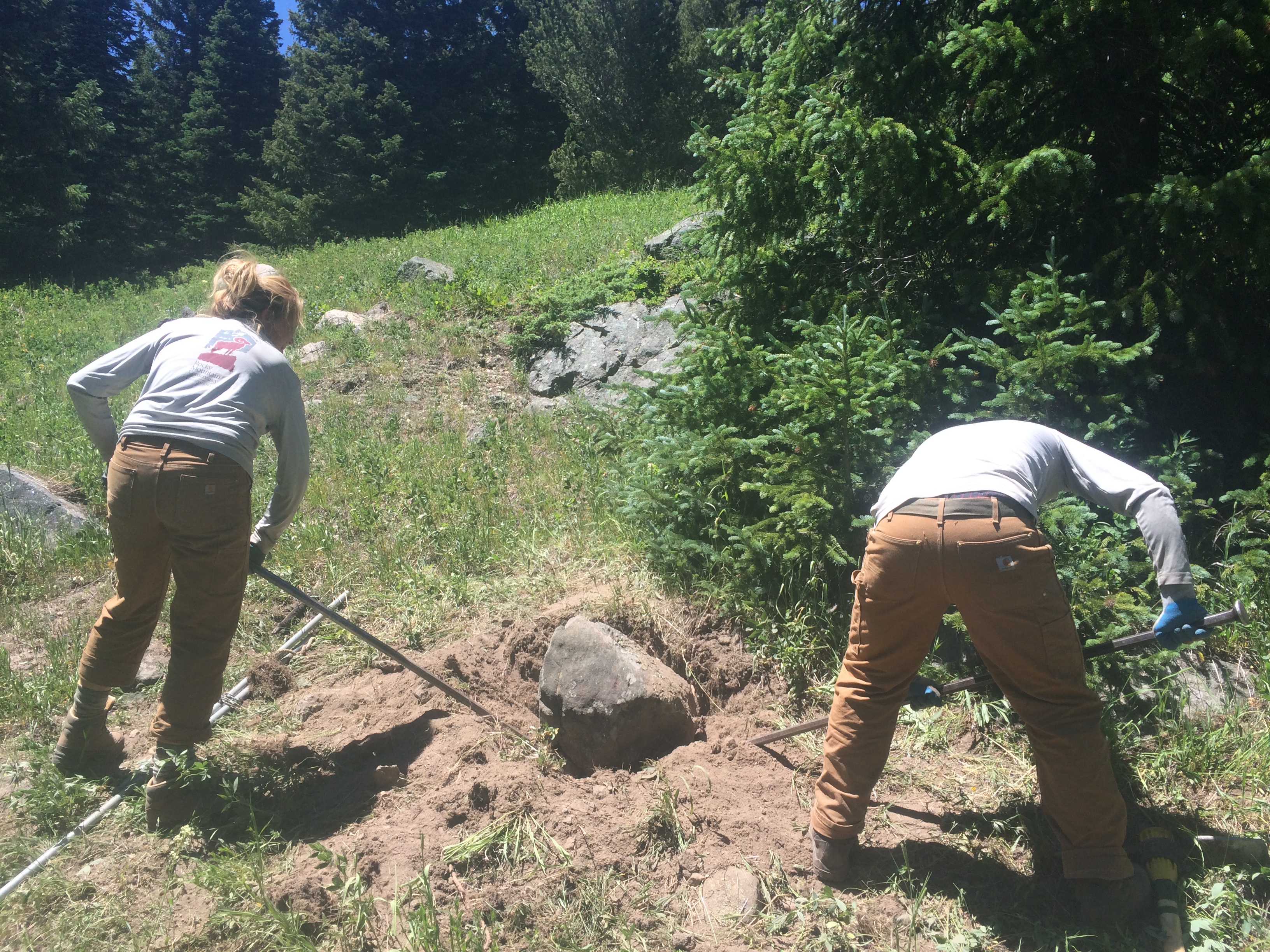

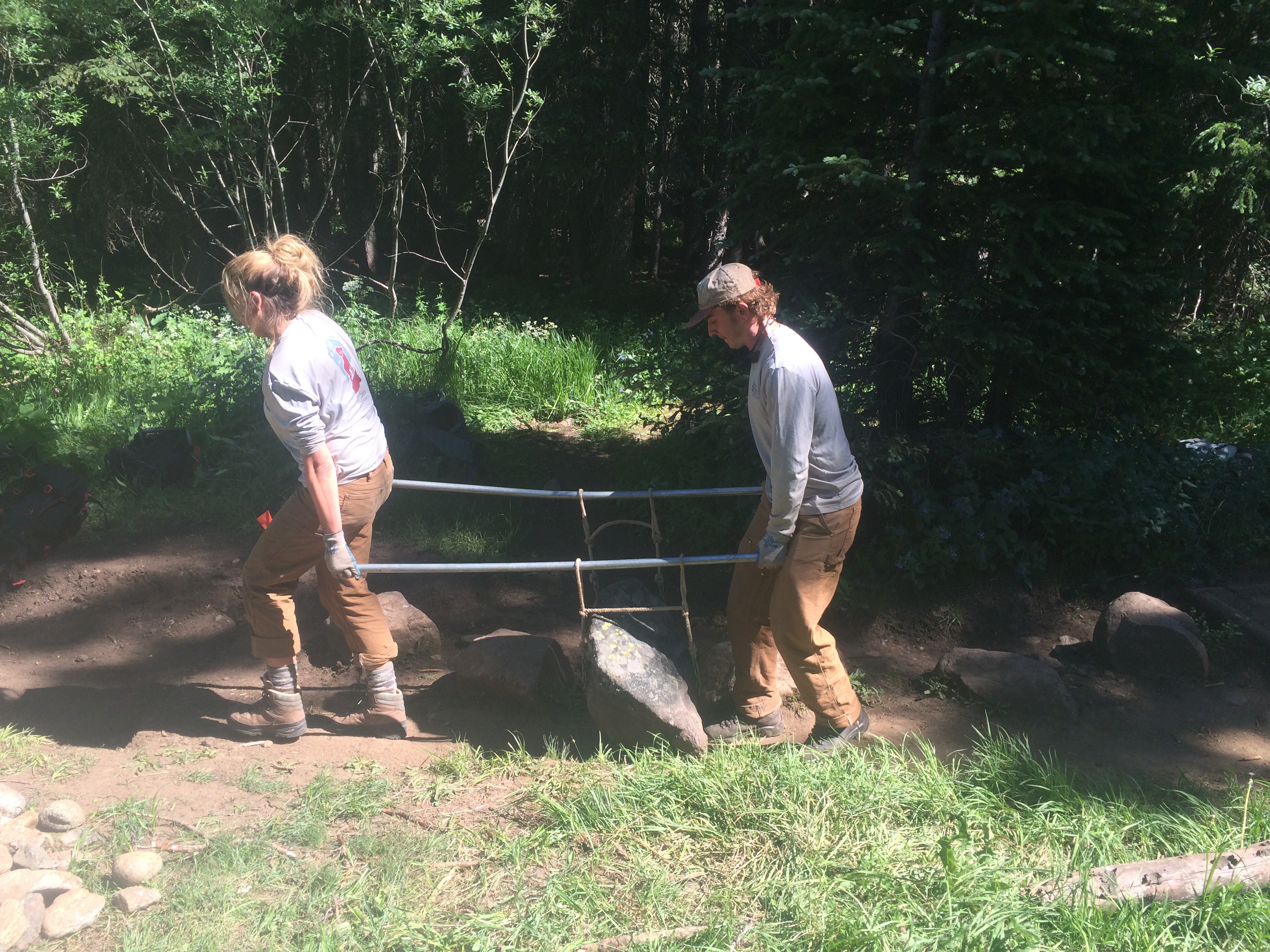

On the final day of the work week, the crew split with half of us going into Brainard Lake to work on the Long Lake Connector and the other half traveling to Ceran St. Vrain to construct a rock retaining wall. At Brainard Lake we spent the entire day removing hazard trees and other trees that were in the corridor of the connector. The connector is going to be crucial to the Brainard Lake area because it will provide an off-road alternative to walking the road from the main parking area in order to access some of the more popular trailheads. The work at Brainard Lake was taxing at times but the need for the corridor kept the crew engaged. At Ceran St. Vrain, the other half of the crew spent their day building a rock retaining wall in an effort to reduce erosion near the trail. It seemed that the general theme of the week was rock collecting, with this half of the crew spending the majority of the day once again collecting rocks of all shaped and sizes.
This week was a little more interesting than usual due to the Cold Spring Fire. The fire started just north of our work center and spread south skirting the east side of Nederland. On Saturday, the fire spread quickly and due to the proximity of the fire it was a major topic of conversation whether we should relocate where we were staying for the week. But thanks to the hard work of our wildland firefighters, the fire was contained within a few days, and our home within Kelly Dahl Campground was safe along with the rest of Boulder County. By the time the blaze reached 100% containment five homes had been destroyed and a little more than 500 acres of land were burned.
-Dalton Moore, Boulder Crew Leader of the Week
This past week the Rawah and Red Feather Crews partnered up with Wildlands Restoration Volunteers (WLRV) back at Young Gulch. Here is each crew’s account of the work completed!
After a great weekend trip to Moab Utah, the Rawah Crew was ready to head back to Young Gulch with Nate, our Wildlands Restoration Volunteers (WLRV) contact and the Red Feather crew. This week had hazards that we discussed every morning before starting our day. Hazards like Rattlesnakes, Poison Ivy, the heat, and tool safety. Both crews did a great job at be spatially aware of each other and being safe of these hazards.
We widened and adjusted the tread of the trail that we established from the week of June 13th. The Wildlands Restoration Volunteers created a switchback turn in previous weeks, and several members of the Rawah Crew lowered the height, made the slope more gradual and widened the tread of the turn. This allows for future mountain bikers and hikers to have an easier transition up or down the trail.
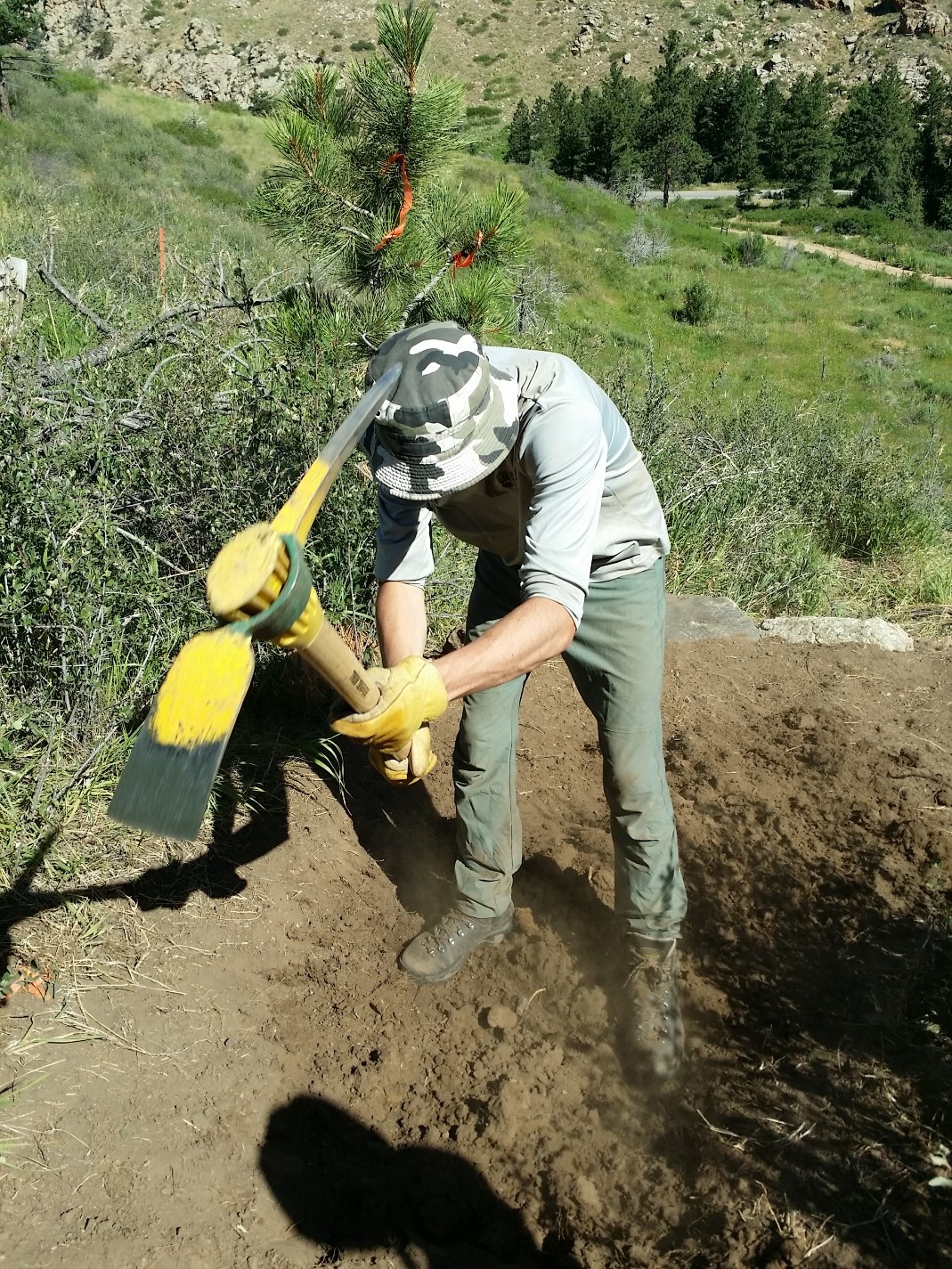

Rawah Crew Member Gus lowering the slope using a Pick Mattock
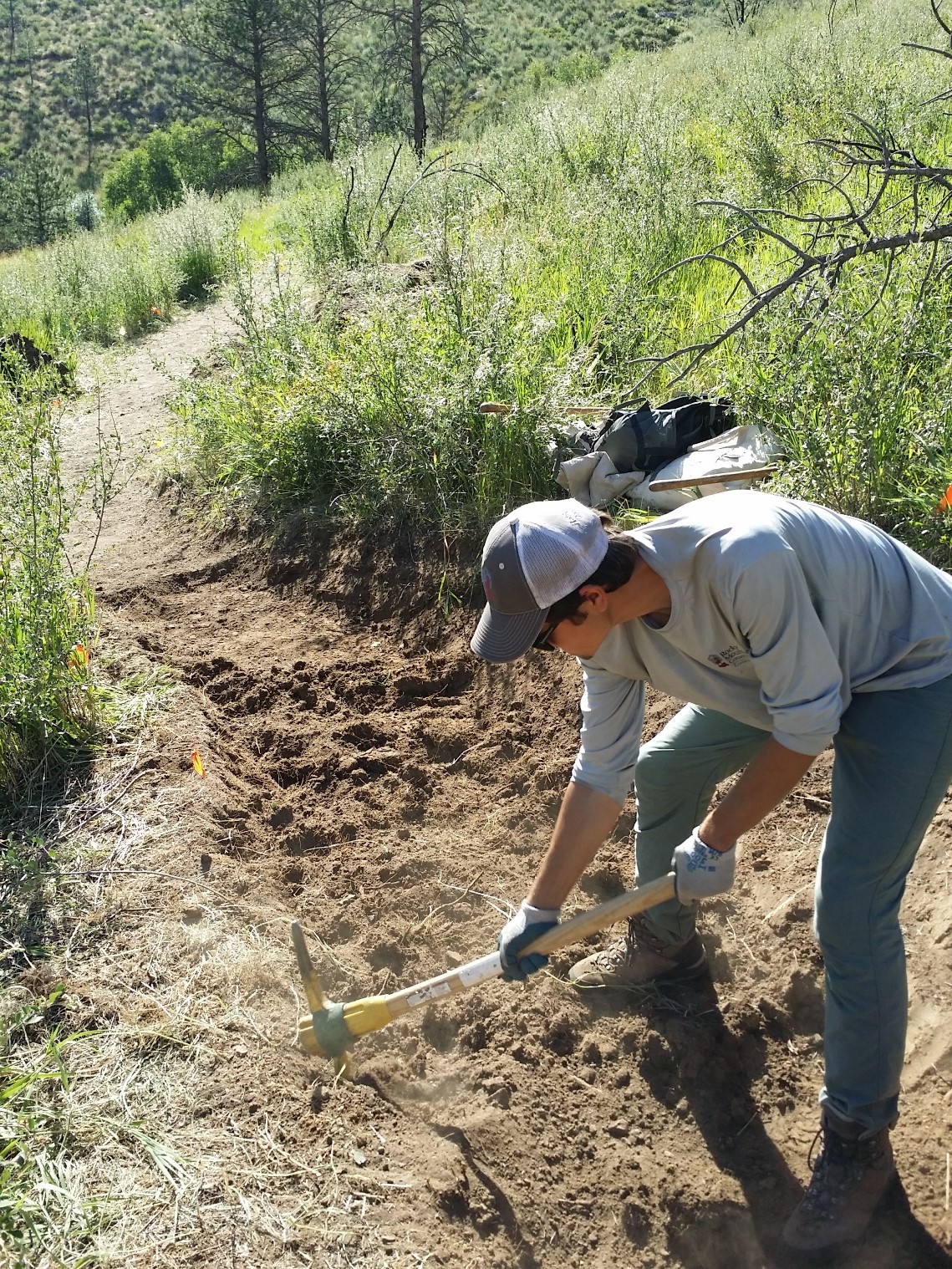

Rawah Crew member Garret adjusting the height of the trail.
Rock walls are a way to support the trail. Three new rock walls were established on the trail, and several more were readjusted to make sure they work effectively. Looking for large flat rocks in tall grass with rattlesnakes around is not fun, but all crew members were safe, vigilant and enjoyed finding rocks that worked well. In order for the rock wall to be stabilized, smaller rocks or “crush” was used to fill in the negative space of the rocks.
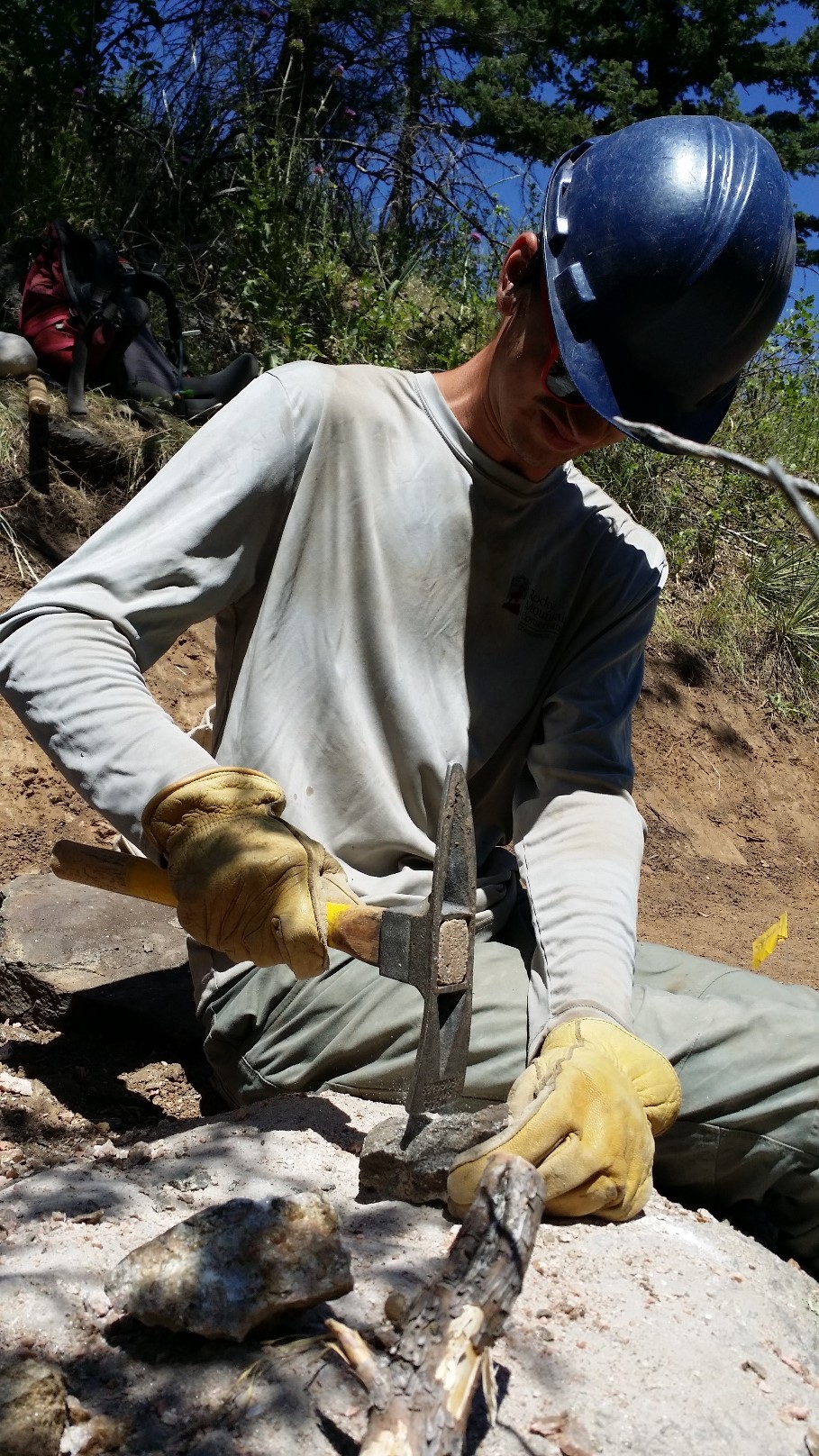

Gus wearing his personal protection equipment to create crush for a rock wall.
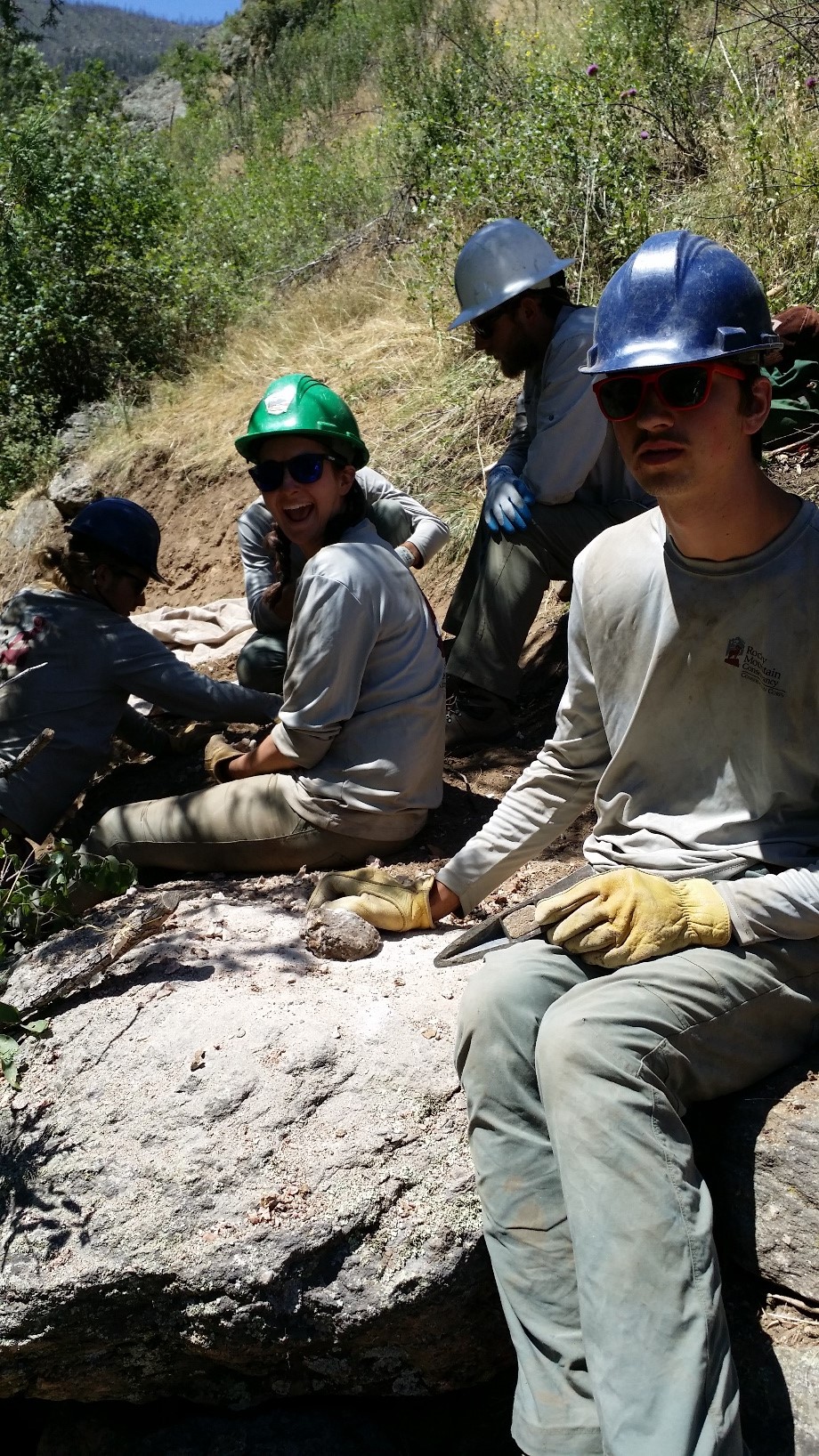

Creating rock walls are fun! Des smiles as Geoff is impressed with the rock wall.
Both crews were able to create a quarter mile more trail after the gulch crossing. Poison Ivy was abundant. However, crew member of the week, Sam Ruhala, used a McCloud to clear away any on or close to the trail. He helped keep both crews safe. The Red Feather crew did more creation, as the Rawah crew did the rock walls and maintenance of the old trail. Being on the Rawah trails can get quite lonely. Aside from the crew, we see very few people on trails or anywhere while we are working. That being said it is always a pleasure working with another crew. Especially one as fun and productive as Red Feather. One of my favorite quotes is by Simon Sinek and it is “If you have the opportunity to do amazing things in your life, I strongly encourage you to invite someone to join you”. At the end of the week we all felt accomplished and proud of our maintenance and creation of the Young Gulch trail. Nate, our WLRV contact, surprised us with two big watermelons to thank us for our work.
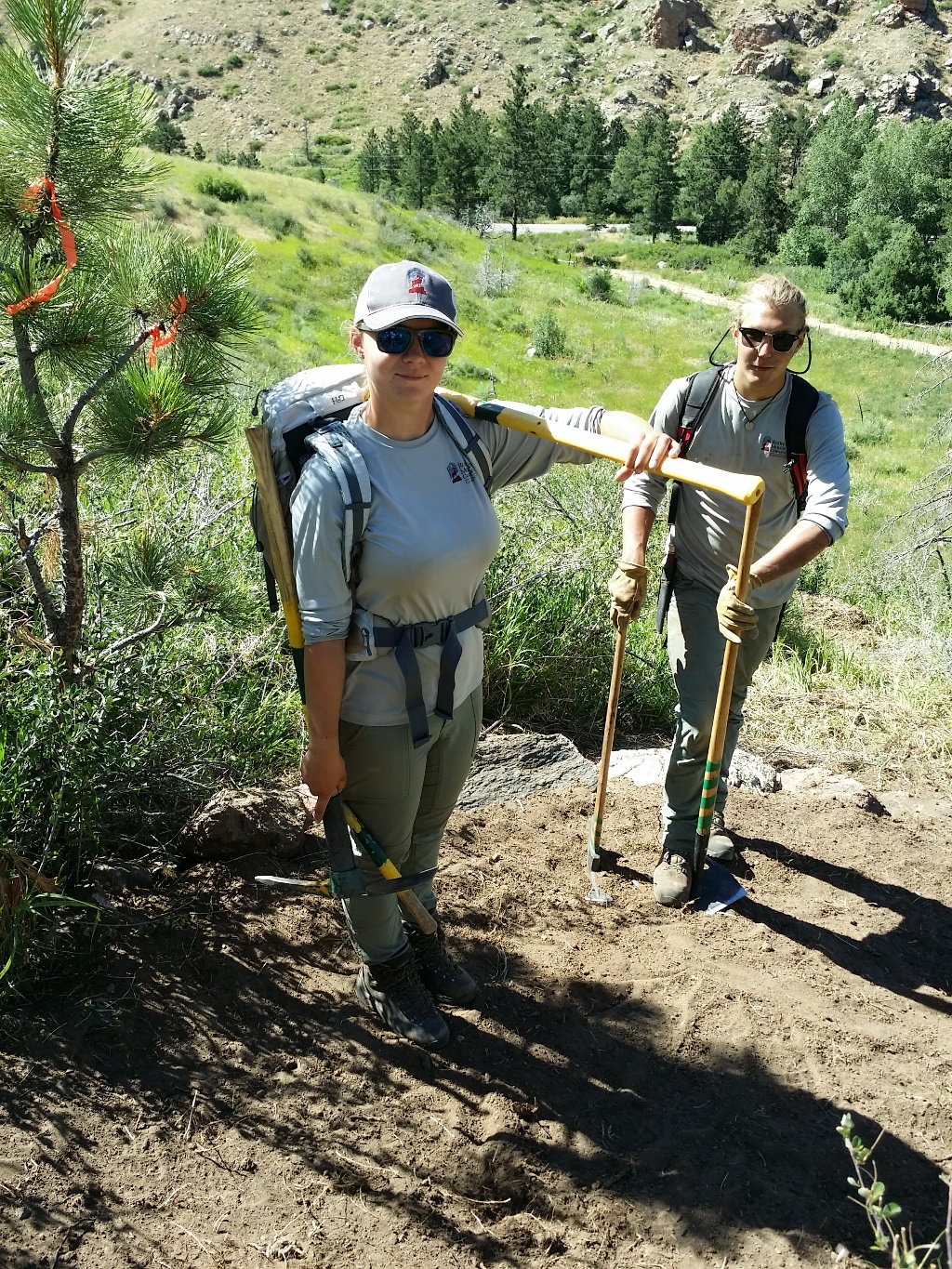

Rawah crew members Kyrie and Sam pose for a picture after a day of work.
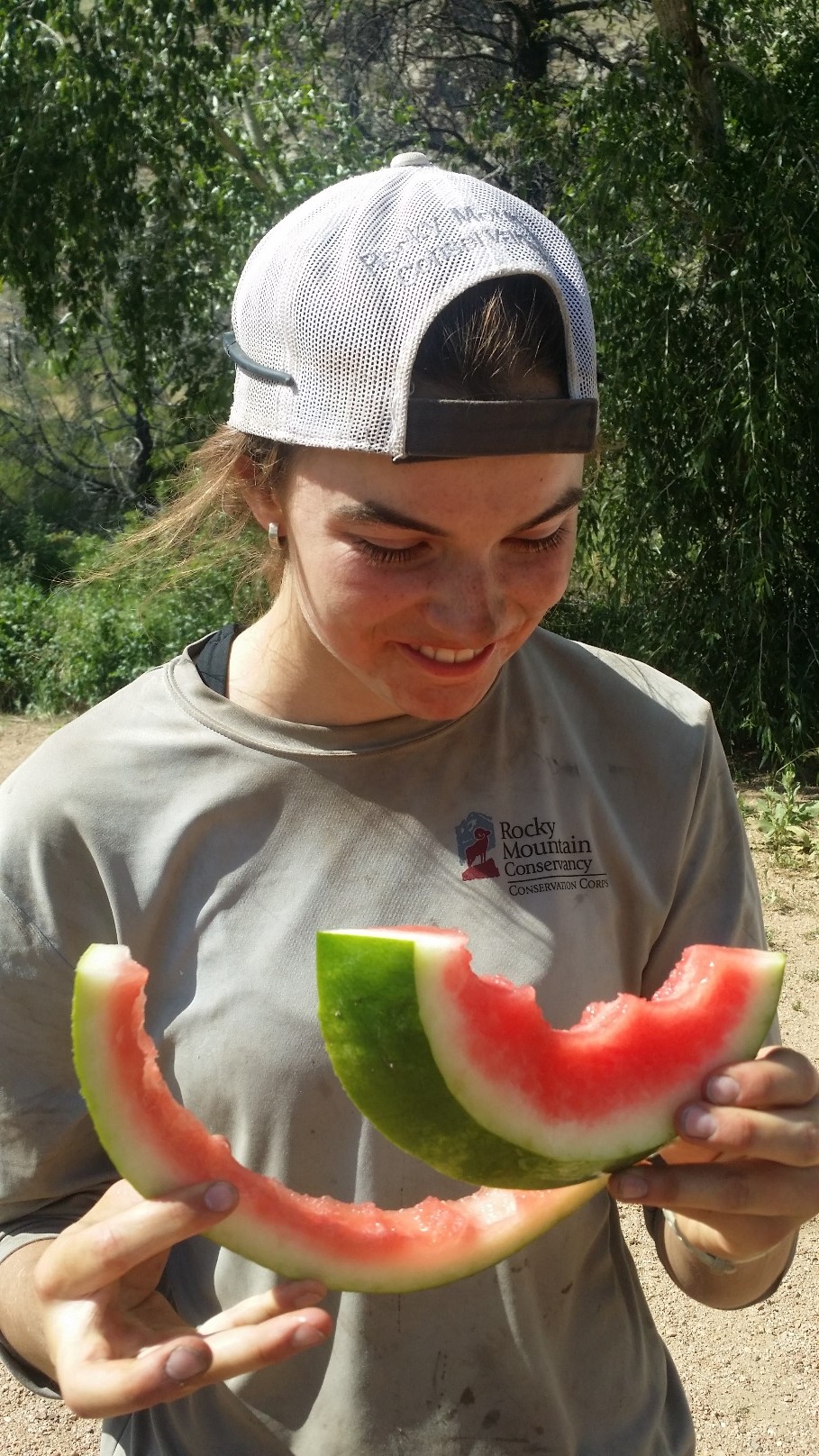

Red Feather crew member Sabrina enjoys the watermelon at the end of a hot, hard week.
-Eeland Stribling, Rawah Crew Leader of the Week
This week July 11th-14th the Red Feather Lakes crew collaborated with the Rawah crew at Young Gulch in the Poudre Canyon. This was the second time the Red Feather Lakes crew has worked with the Rawah crew in Young Gulch, the first time the crews joined forces was the first week when all of the Rocky Mountain Conservancy crews dispersed to their permanent residences until the end of the season. Due to severe floods the Young Gulch has been closed since 2013 and not set to reopen until 2018. Once a very popular hiking and biking trail on the 14 highway west of Fort Collins, the trail was damaged by the high park fire in 2012 and only days after reopening in September 2013 until the torrent took out majority of its trail. The two crews, Red Feather Lakes and Rawah, have been working with the forest service to rebuild a new route that is more sustainable.
Our objective, this week, in Young Gulch was to reinforce and fine tune sections that had been previously worked on. We did this by back sloping and leveling out the tread and inaugurating a drainage grade. Section notes were provided to both crews which helped immensely. Each section was cut into 100 foot long blocks of which there were 23 blocks that we worked on, that’s close to half a mile of work done in 4 days. A lot of what we did consisted of hauling many loads of dirt and transferring from different sections of the trail. We stored much of the trail materials into designated piles consisting of rock piles, mineral soil piles, and organic soil piles. Our biggest concerns with the trail were the rattle snakes, which we saw several in a days’ work and the poison ivy that the crews had cleared out to create pathway.
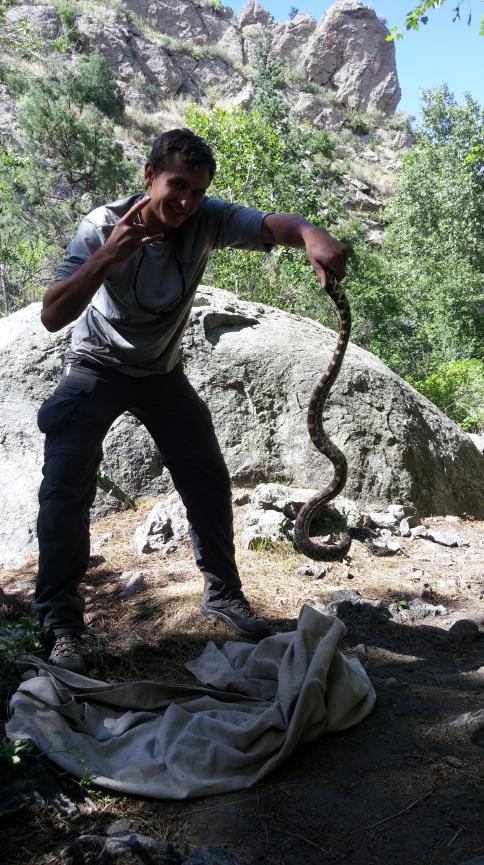

The picture above is the adventurous Wyatt from the Red Feather Lakes crew holding a bull snake that he found on the trail. Wyatt is fearful when it comes to finding wildlife, but his curiosity supersedes his fear of handling the wildlife. The Young Gulch has a mélange of wildlife from shrubs, ponderosa pine, juniper and Douglas fir along its’ hillsides. Along with the vegetation Young Gulch also has different breeds of snakes, fish, and deer.


The picture above (from left to right) is Wyatt, with the Red Feather Lakes crew, Sam, with the Rawah crew, and Daina, with the Red Feather Lakes crew. All three of the crew member’s just completed a drainage grade by carefully selecting melon-sized rocks and by depositing each one along the inside of the turn and finishing it off by adding crushed rock in between the larger ones to hold them into place. The Drain was made because the natural flow of water ran right in that section of the turn so the drain keeps the trail from eroding.
Many of the crew members agree that working in Young Gulch has been their favorite project yet because they are able to see a brand new trail put in with their very own efforts and this give everyone a great sense of achievement. Everyone has worked adamantly to create this trail and you can see that the work that was put into it was made carefully and diligently.
-Daina Daniels, Red Feather Crew Leader of the Week
I was fortunate enough to make it out to the Young Gulch project this past week and took some photos of my own. Here they are:

